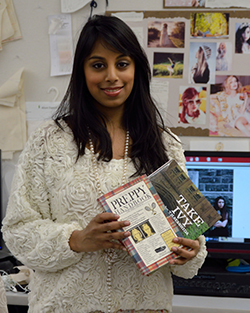Student traces threads of prep style since 1920s
By Sarah Cutler

Anu Lingala ’13 has prepped for prep.
Drawn to the widespread influence of prep style, Lingala has extensively researched since her freshman year in Fiber Science & Apparel Design the origins and exclusivity of the culture. A Hunter Rawlings Cornell Presidential Research Scholar, she’s writing her honors thesis on the history of prep style, and her research influenced her collection for last spring’s Cornell Fashion Collective show, she said.
A paper she wrote on the topic was accepted at the Popular Culture Association/American Culture Association national conference in Washington, D.C., held March 27-30.
“This is a story of the blending of conventional academic research with creative studio work,” said Charlotte Jirousek, associate professor of fiber science and apparel design and Lingala’s faculty adviser.
Though it typically has a “sportswear element” – combining dressy and casual clothes – prep style is hard to define, Lingala said, because it means different things to different people.
“It’s been diluted a lot; it’s really a derivation of young boys’ prep school uniforms that has evolved through its prevalence in WASP [white Anglo-Saxon Protestant] society and elite universities,” she said. “Each of those things had an influence.”
Much of Lingala’s research for the paper involved reading books and college newspaper archives written from the 1920s onward about colleges, prep schools and the development of an American aristocracy.
“I took elements of what I saw there [about fashion] and made inferences from that,” Lingala said. “There were a lot of things that are insightful about what people thought about what they were wearing.”
Lingala’s research focus was strongly influenced by “Take Ivy,” a celebrated fashion photography book by Japanese authors that documented prep style on American college campuses in the 1960s. Published originally in Japanese, the book was translated into English during Lingala’s freshman year.
“The way they write it, it’s in a very scientific, observational manner” to inform a Japanese audience of this different type of style, she said. “They say things like, ‘Oh, he’s wearing shoes without socks. How interesting.’”
At last year’s Cornell Fashion Collective runway show, Lingala’s collection played off the similarities between punk and prep style. She used such fabrics as tweeds and plaids, which have been used in both styles.
“I found fabrics that overlapped between the two and combined them,” she said. “It was a tangent I came across in my research that I didn’t flesh out in my thesis.”
Lingala’s paper and honors thesis focus instead on the origins of prep culture and how the style became a part of upper-class American society.
“Most literature talking about preppy, elite clothing just says it came from the Ivy League and prep schools, but it doesn’t say why,” Lingala said. “I go back and look at British prep schools and see why prep is part of that culture.”
Lingala still sees prep style on campus, to which she attributes many students’ upbringing in upper- and upper-middle-class homes in the Northeast. But she noted that the commercialization and mass production of the style at the end of the 20th century may also be a factor.
“In many ways,” she said, “certain aspects and pieces of traditionally prep style have become part of the larger realm of American men’s sportswear.”
Unfortunately, for personal reasons Lingala was not able to attend the conference and needed to withdraw her paper. Nevertheless, the fact that it was accepted was an unusual distinction for an undergraduate.
Lingala will be one of some 40 student designers displaying their original garments at the annual Cornell Fashion Collective spring runway show scheduled for 7:30 p.m. April 27 in Barton Hall.
Sarah Cutler ’16 is a student communications assistant for the College of Human Ecology.
Media Contact
Get Cornell news delivered right to your inbox.
Subscribe